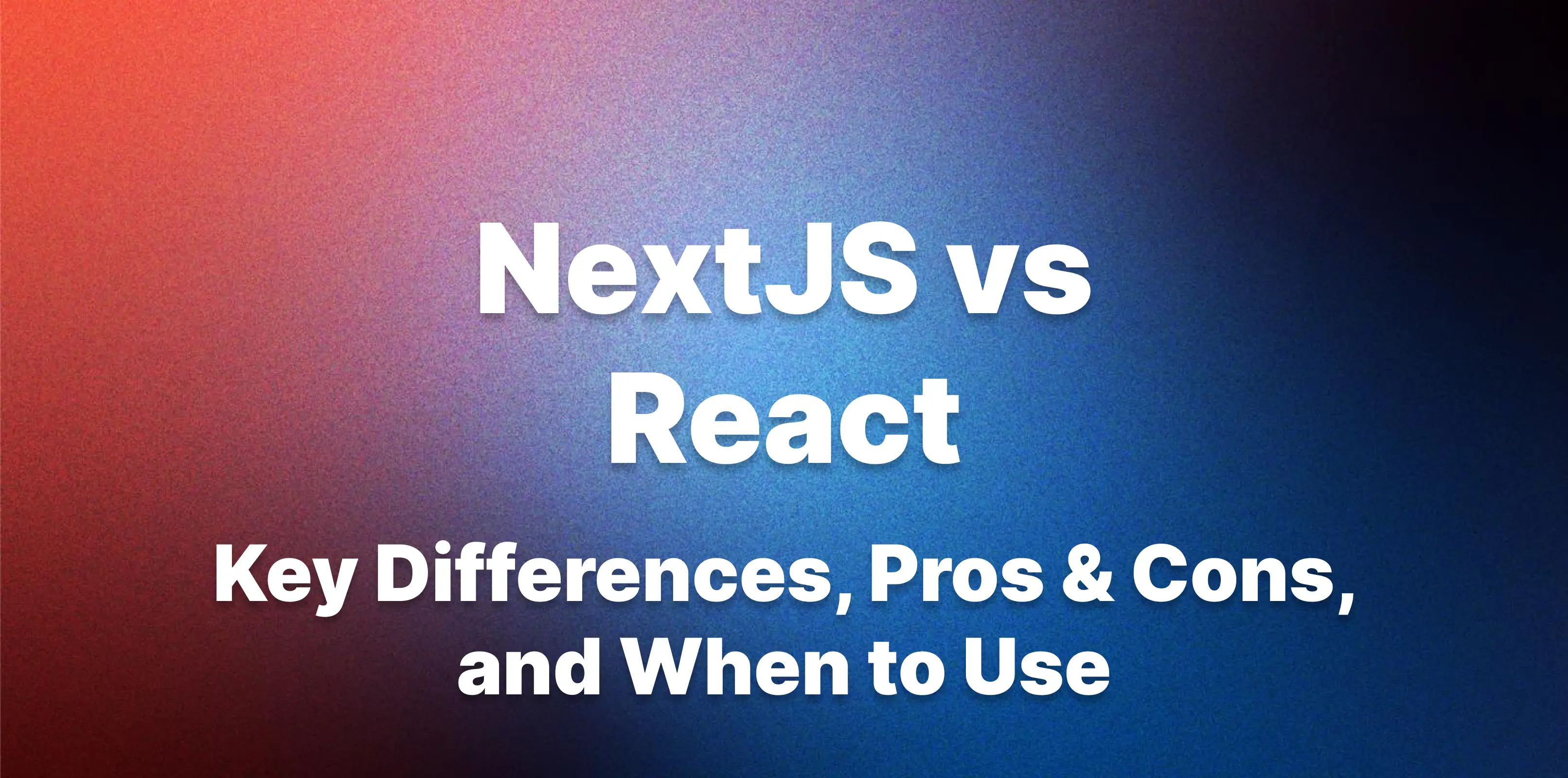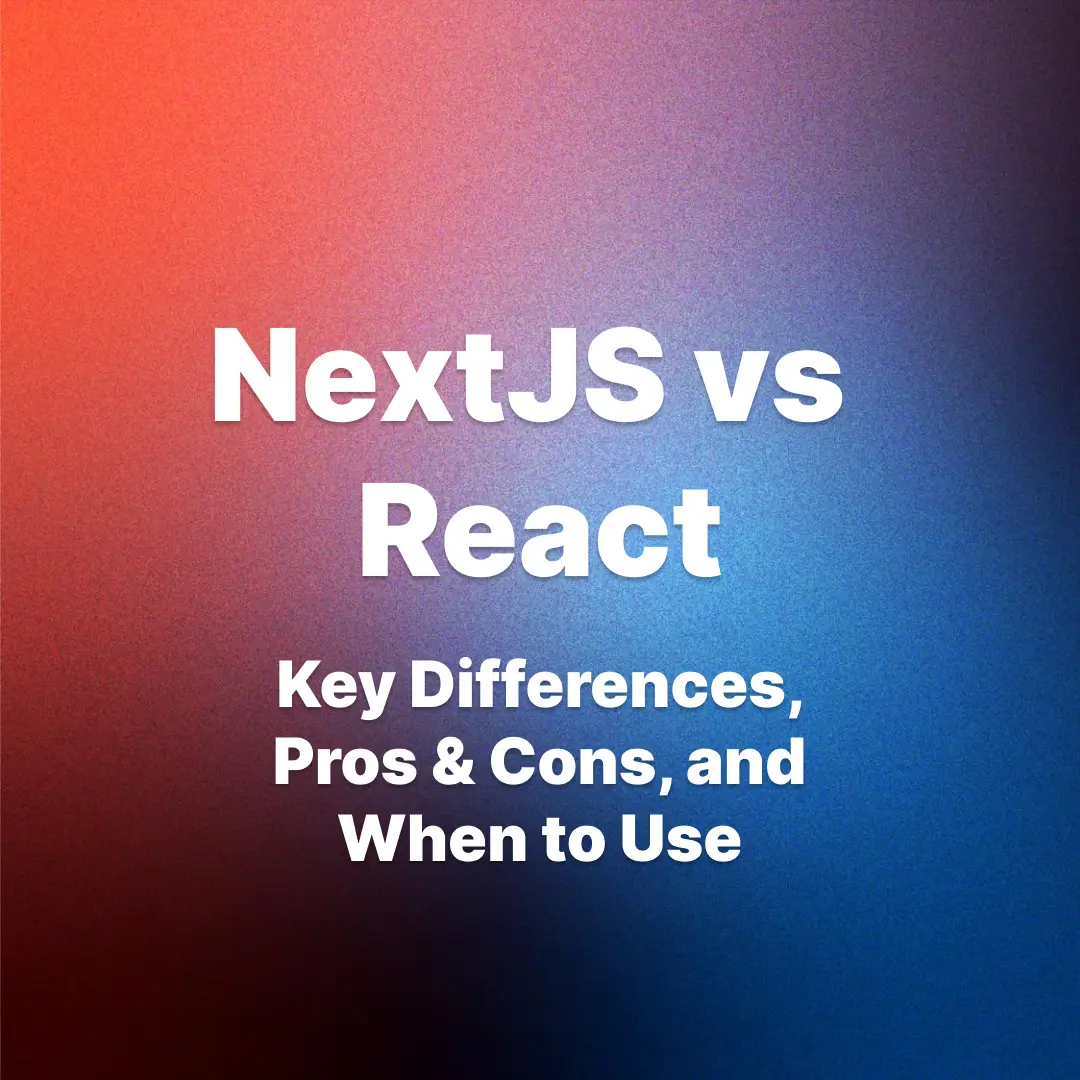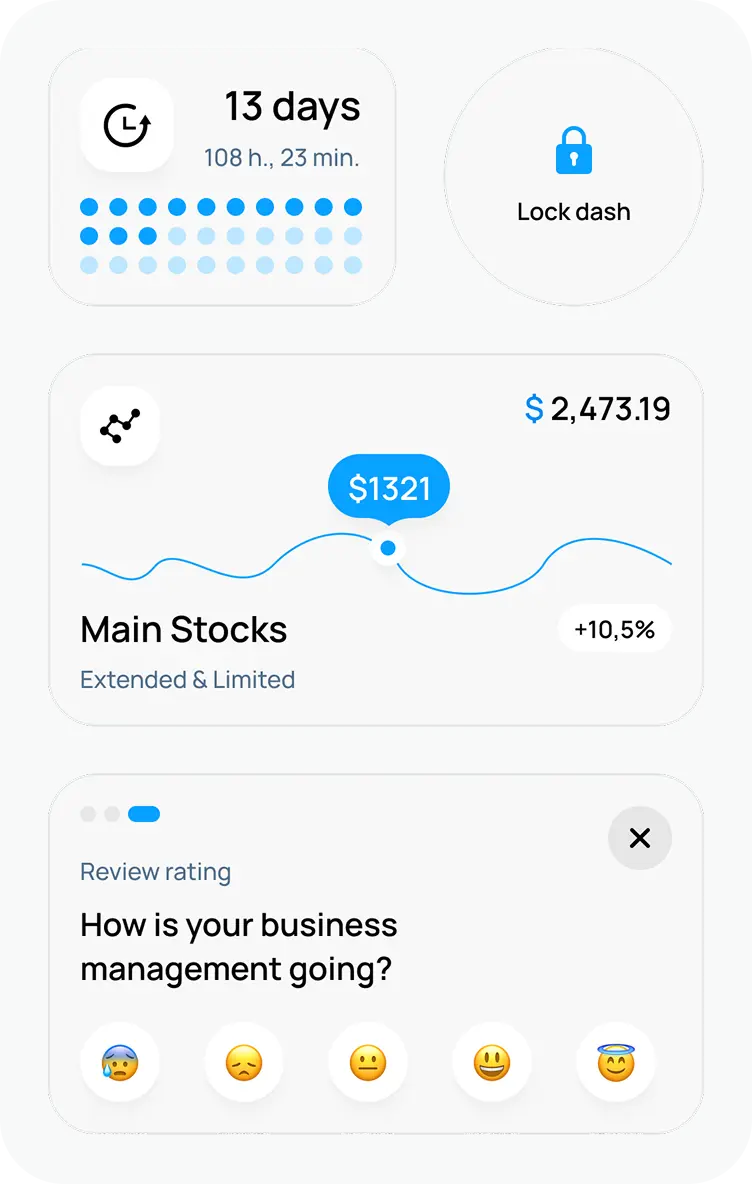Next.js vs React: Key Differences, Pros & Cons, and When to Use
August 12, 2025•12 min read

I hope you enjoy reading this post. If you want us to do your frontend development or design, click here.
Author: Alex Vasylenko | Founder of The Frontend Company


Choosing the right frontend technology is a strategic move with an impactful butterfly effect across your entire product lifecycle. It's about aligning your business goals, team structure, and scalability in a market with tons of options.
In 2026, React and Next.js stand out as two of the most widely used tools, but they take fundamentally different approaches. In this article, I aim to break down these differences and explain when to use each one so you can make the right call with clarity and confidence.
Let's dig in.
What Is React?
React is an open-source JavaScript library developed and maintained by Meta, first released in 2013. It's the backbone of many modern web UIs today, and for good reason.
React is all about building user interfaces from small, reusable components. Rather than manipulating the DOM manually (the old-school way), you declare what the UI should look like at any given moment, and React takes care of rendering the how. It does this efficiently, using a concept called the Virtual DOM — a lightweight copy of the actual DOM that React uses to calculate and batch changes, minimizing expensive operations in the browser.
It's widely used and forms the foundation of frameworks like Next.js, Gatsby, and Remix. React also supports the development of iOS and Android apps with React Native.
Here are a couple of numbers to put React's popularity into perspective:
React is used by 40% of developers worldwide.
238k stars on the official React GitHub page.
Key Features of React
React has remained the brilliant choice for frontend development, not just because of its popularity but also because of the simplicity and power it brings to complex interfaces. Let's unpack what makes React so effective under the hood.
1. Virtual Document Object Model (DOM)
When the state changes, React first updates the Virtual DOM. It then performs a diffing algorithm to compare this virtual version with the actual DOM. Only the parts that actually changed are updated in the browser.
As a result, efficient rendering is possible even in complex applications with thousands of dynamic elements.
React uses JSX (JavaScript XML), a syntax extension that allows developers to write HTML-like code directly within JavaScript.
JSX streamlines component logic, making it easier to reason about how UI is generated and how it behaves. You get the power of JavaScript with the familiarity of HTML, and it compiles down to regular JavaScript functions.
Here's a basic example:

It's readable, declarative, and expressive when developers deal with dynamic content.
React apps are composed of components — self-contained pieces of UI logic that can be reused, composed, and managed independently. Devs can create a <Header>, <Footer>, or a <Chart> component and plug them together like LEGO blocks.
Each component can manage its state and behavior. This approach makes apps easier to build, test, debug, and scale.
Example: Modular React App

This architectural pattern is ideal for building design systems, where components must be standardized and reused across multiple products.
4. React Gives Developers Total Control
React gives developers complete control without enforcing strict rules. It's a library, not a framework — which means devs are free to choose how they handle routing, data fetching, state management, and deployment.
They architect your frontend the way you want and can optimize for performance, scale, or developer experience without fighting against the framework.
💼Best Use Cases for React
Some real-world scenarios where React really shines:
Single-Page Applications (SPAs): Ideal for apps with dynamic client-side navigation (Gmail, Trello).
Internal Tools: CRMs, dashboards, admin panels, where SEO isn't necessary, and UX is.
Design Systems & Component Libraries: Companies like Shopify and Atlassian use React to power shared UI systems across their product suites.
Progressive Web Apps (PWAs): With service workers and client-side rendering, React can be used to build PWAs that are fast, reliable, and responsive, regardless of the device or network conditions.
Social media platforms, economy platforms, media platforms, online video streaming platforms, and SaaS tools.
Drawbacks of React
React's biggest drawbacks lie in what it doesn't provide out of the box. By design, it focuses only on the UI layer, which means features like routing, server-side rendering, or state management beyond the component level require additional libraries or frameworks. Some common limitations include:
No Built-in Routing or SSR: React does not include a routing solution or server rendering by default. If you need to build a multi-page app or want server-rendered HTML for SEO, devs must manually set up libraries or use frameworks.
SEO Limitations: Because a standard React app renders content in the browser, search engine crawlers may struggle to index your content. For public-facing marketing sites or content-heavy websites, vanilla React is not particularly SEO-friendly without additional assistance.
Performance Tuning Overhead: React's Virtual DOM is efficient, but as your app grows, devs need to apply performance optimizations manually. They can improve performance with code splitting, lazy loading, and other techniques, but these require extra setup and careful optimization.
Boilerplate and Tooling: Since React is a library and not a full framework, setting up a complete project requires additional tools. Developers will typically need a build system, a transpiler for JSX, and often state management libraries (such as Redux or Zustand) for larger applications.
Despite these drawbacks, React remains enormously popular. It has a massive ecosystem of third-party solutions for any problem.
What Is Next.js?
Next.js is an open-source framework built on top of React by Vercel, first released in 2016. Next.js was designed to simplify the development of React applications by providing a set of conventions and features that React alone doesn't have: routing, rendering strategies (SSR, SSG, ISR), API routes, image optimization, and more — all out of the box.
Think of React as the engine and Next.js as the car — React powers the UI, and Next.js gives you the full set of tools to build, deliver, and scale web applications with improved performance and SEO.
Today, Next.js is used by thousands of companies to power e-commerce platforms, SaaS dashboards, marketing sites, and high-performance apps.

Transform your UI for peak performance!
🔹
Unlock seamless, high-performance frontend solutions tailored to your business.
🔹
Get an interface that outshines competitors and delights your users.
Key Features of Next.js
Here's what makes Next.JS one of the most capable and widely adopted frameworks in 2026.
1. Hybrid Rendering (SSR, SSG, ISR)
Next.js supports multiple rendering methods, all within the same project:
Server-Side Rendering (SSR): Content is generated on the server for each request, perfect for dynamic pages.
Static Site Generation (SSG): Pages are built at compile time and served instantly via CDN.
Incremental Static Regeneration (ISR): A hybrid model — pages are prerendered and then revalidated in the background as content updates.
This flexibility allows teams to balance performance, scalability, and SEO on a page-by-page basis.
2. File-Based Routing
Routing in Next.js is based on the file structure. Add a file in the /pages or /app directory, and you've got a route. It supports dynamic routes and nested routes without requiring an external router, similar to React.
This eliminates boilerplate and makes it easy to understand the app structure at a glance.
3. Built-In API Routes
Next.js allows developers to create backend endpoints directly in the project using API routes. These are serverless functions that live alongside your frontend code and are perfect for handling form submissions, auth, or lightweight backend logic.
4. Image Optimization
Next.js includes a built-in <Image /> component that handles:
Lazy loading
Responsive resizing
Format conversion (e.g., WebP)
It significantly improves Core Web Vitals and keeps page loads fast — a major win for SEO and user experience.
5. Middleware and Edge Functions
Next.js supports middleware that runs before a page loads. Developers can use this to manage authentication, localization, A/B tests, or redirects.
Paired with Edge Functions, this logic can run close to the user, improving latency and enabling faster experiences without hitting your origin server.
6. React Server Components and Streaming
The App Router, introduced in Next.js 13+, unlocks React Server Components — a modern approach where components render on the server and ship zero JS to the browser.
Combined with streaming, it sends HTML as soon as it's ready instead of waiting for the full page to be assembled.
This results in faster initial loads and smaller bundles, ideal for large-scale apps and performance pages.
7. Built for Speed and Developer Experience
Next.js comes packed with tools that help dev teams ship faster:
Hot reloading and fast dev server (via Turbopack)
Built-in TypeScript and ESLint support
Smart code-splitting and automatic prefetching
Zero-config support for CSS, SCSS, Fonts, and more
Everything is designed to eliminate unnecessary decisions and let teams focus on building, not wiring up tooling.
💼 Best Use Cases for Next.js
Some scenarios where Next.js is the clear choice:
SEO-Heavy Applications: Marketing sites, blogs, and news platforms where content must be crawlable by search engines.
Hybrid Apps: Sites that need a mix of static content and dynamic user pages.
E-commerce Platforms: Where page load speed and product SEO impact revenue.
Documentation Sites and Developer Hubs: Fast, searchable, and frequently updated content.
SaaS Dashboards with Server Logic: Admin panels, analytics apps, or tools that benefit from server rendering and built-in APIs.
Global Apps Requiring Performance: Platforms needing low-latency personalization or regional routing.
Examples include Vercel's dashboard, TikTok's marketing site, HashiCorp's documentation, and Notion's marketing pages.
Drawbacks of Next JS
Next.js offers an impressive set of features out of the box, solving many of React's gaps, but introduces a few of its own.
1. Hosting Overhead and Runtime Requirements: Unlike React apps, Next.js applications that use SSR, API routes, or middleware require a Node.js runtime or serverless platform. You can't just drop them into a static host like GitHub Pages or an S3 bucket. For small projects or static-only sites, this can bring unnecessary complexity and cost at scale.
2. Backend Limitations: Next.js supports backend logic via API routes, but these are limited to lightweight serverless functions. For apps with complex data handling, long-running processes, or real-time requirements, you'll still need to build and maintain a separate backend service.
3. Less Flexibility: Next.js file-based routing, rendering rules, and directory structure are efficient — until they don't fit your use case. Custom-built pipelines, non-standard routing logic, or highly specific deployment models can quickly push against the framework's boundaries. In those cases, customization often requires workarounds or abandoning Next's default behaviors entirely.
4. Learning Curve and Ecosystem Complexity: Next.js has several new concepts on top of React, like getStaticProps, getServerSideProps, middleware, the App Router, and React Server Components.
These features can confuse teams unfamiliar with modern React. As the framework evolves fast, staying current with best practices and changes can require additional time and attention.
However, do not dwell too much on these limitations, as Next.js remains the top choice for building fast, SEO-friendly, production-ready web apps. It's just best suited for projects that benefit from its conventions.
Key Differences: Next.js vs React
After we've discovered the key features and drawbacks of each technology, let's look at their differences through a detailed analysis.
1. Library vs. Framework
React is a UI library focused on building components and rendering to the DOM, and it leaves many decisions to the developer. Next.js is a framework built on React that provides a complete solution for routing, rendering, and bundling. In other words, React is the engine, and Next.js is the whole vehicle.
2. Routing
In React, routing is manual – developers typically use a library like React Router and define routes in code. They need to add an extra setup step for routing, but potentially offer more customization options. In Next.js, routing is file-based and automatic. Devs create a page file, and it's automatically available at a route.
3. Rendering Models (CSR vs SSR/SSG/ISR)
By default, React uses Client-Side Rendering (CSR) – the initial HTML is minimal, and a bundle of JS renders the UI in the browser. Next.js supports Client-Side Rendering (CSR) for interactivity, but crucially, it also adds Server-Side Rendering (SSR) and Static Generation (SSG) as first-class capabilities. This is one of the biggest differences.
Next.js outperforms React in terms of performance due to SSR and SSG. Pages are rendered before reaching the browser, so users wait less for content.
4. Performance Optimization
Developers can build high-performance web apps with React and Next.js, but Next.js has many built-in optimizations due to its framework nature. With React, achieving optimal performance is developer-dependent – they'd implement code-splitting, optimize images manually or via third-party libs, and so on. Next.js automates a lot of this.
5. Developer Experience (DX) & Productivity:
Next.js offers a streamlined DX with convention over configuration. Teams adopting Next can follow a standard project structure and use built-in features instead of researching libraries for each concern. Personally, when I first worked with Next.js, I was surprised to see how its features streamlined my development experience and increased my productivity. React provides developers with maximum flexibility, whereas Next reduces the amount of boilerplate code.
6. Ecosystem and Scalability:
React is supported by a huge community, lots of tutorials, and many third-party libraries. So, despite developers needing many solutions for optimization, state, testing, and more, they can find them easily.
As I said before, Next.js is an all-inclusive framework, so it reduces the need to import multiple external libraries for routing, data fetching, etc.
In terms of scalability, both React and Next can scale to large applications, but the approach differs. With React, scaling means establishing your conventions and design systems to organize a growing codebase. Next scales by dividing things into pages and modules according to its framework structure, which works well for huge apps like TikTok.
When to Use React vs Next.js
Both React and Next.js are powerful, and choosing between them (or deciding how to combine them) depends on your project's needs and your team's situation. Since Next.js is built on React, it's not always an either-or choice – it can be a question of using React alone versus React in combo with Next.js.
NEED HELP TO CHOOSE THE RIGHT TECH STACK?
Book a FREE 1-hour call with our team and we will help you make the right choose
Below are scenarios for when you might choose one over the other:
Use React Standalone when:
You need maximum flexibility or have a custom setup.
If your project demands complete control over every aspect of the frontend – e.g., a custom build pipeline, unique routing logic, or integration into an unusual environment – React gives developers the freedom to architect.
You're adopting or embedding UI into an existing app.
React is ideal for gradually upgrading legacy systems or adding interactive widgets to non-React apps. If you already have a backend serving HTML and just want to incorporate some interactive React components, using React standalone is a lightweight approach.
SEO is not crucial, and the app is primarily a single-page application (SPA) or an internal tool.
If you're building an authenticated SaaS dashboard, an admin panel, or any application where search engines and initial load SEO aren't relevant (perhaps it's behind a login or for internal use), a client-rendered React app is often sufficient. You can use React Router for multi-page flows within the app, and you won't be penalized by Google for loading content via API calls.
You have a separate backend team/service and need a frontend.
In some architectures, the frontend is purely a consumer of a robust external API. If your team's workflow cleanly separates the frontend and backend, you might choose React for the front and let the backend handle data via REST/GraphQL. Using React alone would reduce complexity when SSR is not needed.
You want to keep the bundle size small.
A raw React app can be very small, especially if you customize the build and only include exactly what you use. For performance-critical applications like an embedded widget on third-party sites, minimizing every byte might be easier with a tailored React setup.
In practice, if your application might eventually need Next.js features, you can start with React and later migrate to Next when needed – since Next.js is essentially an extension of React. Many teams start with a React App for SPAs and only adopt Next once server rendering or other features become necessary.
Use React with Next.js When:
You need a fast time-to-market.
If you're looking to build and deploy a product quickly, Next.js significantly reduces setup time. Teams that want to focus on features rather than configuring Webpack or setting up server routing will benefit from this approach.
SEO and performance are top priorities.
This is a key reason many choose Next.js. For a public-facing website where search engine visibility can make or break success, Next.js is often the better choice. The ability to serve fully-formed HTML to crawlers and users means better SEO and usually better user experience. If you're worried that React isn't SEO-friendly, it's a strong sign to consider using Next.js.
You have a content-heavy or hybrid application.
If your app is something like a blog, documentation site, news site, or has a mix of static and dynamic content, Next.js was born for this. Use static generation for the content that can be published and SSR for parts that need freshness.
You want to leverage edge computing and global CDN deployment.
Next.js on Vercel can deploy your site such that users around the world get very fast responses. If your user base is global and performance across regions is important, Next's built-in support for incremental static regeneration and edge functions is a plus.
Your team prefers convention and has full-stack JavaScript skills.
In a scenario where your developers are comfortable with Node.js and React, using Next.js lets them work on both frontend and backend in one project. This can improve collaboration and reduce context switching. If you have a small team of "generalist" developers, it's often easier to manage a Next.js codebase than to coordinate changes across separate frontend and backend repos.
Your app benefits from the latest React innovations quickly.
Next.js is often among the first frameworks to support new React features (like React 18's streaming, Suspense for data, Server Components, etc.). If you want to take advantage of React Server Components today, you practically use Next.js, as it provides the necessary infrastructure for it.
Use React for flexibility and simplicity when you either don't need what Next provides or actively don't want those abstractions. Use Next.js when you need those additional capabilities and want to save time, gaining performance and SEO benefits out of the box.
Next.js vs React: What's the Right Choice?
Both React and Next.js are excellent tools for building modern web applications — but they solve different problems.
React is a flexible UI library that gives you control over your architecture. It's ideal for teams building design systems, internal tools, or SPAs where SEO isn't a concern. It's lightweight, battle-tested, and supported by a massive ecosystem and talent pool.
Next.js is a full-featured framework built on top of React. It's designed for speed, SEO, and scalability — perfect for teams that need hybrid rendering, built-in routing, and backend logic without spinning up a separate server. It enforces structure, accelerates time-to-market, and handles many performance concerns out of the box.
If you need full control and want to architect every piece yourself, go with React.
If you want to move fast with built-in best practices and great defaults, Next.js is the better choice.
Want to build an app using cutting-edge frameworks? Reach out to us, and let's develop a brilliant product.

Unlock the full potential of your product

Boost customer retention & satisfaction

Become more competitive on the market

Move to the latest technologies stacks

Improve usability & visual appeal
FAQ

Alex Vasylenko is the founder of The Frontend Company, DBC and several other successful startups. A dynamic tech entrepreneur, he began his career as a frontend developer at Deloitte and Scandinavia's largest banking company. In 2023, Alex was honored as one of 'Top 10 Emerging Entrepreneurs' by USA Today.
RATE
Rate this article please
This will help us provide more useful information.
1299 ratings, average 4.91 out of 5
